Microdosing of nitrogen fertiliser and cattle manure under in situ rainwater harvesting to improve maize production in smallholder farming system in a semiarid area of Zimbabwe
Abstract
Introduction
Maize production in smallholder farmers located in semiarid areas of Zimbabwe are mainly constrained by soil moisture and nutrient stress. Moisture stress is mainly due to erratic rainfall, high rates of evapotranspiration and limited knowledge of the use of in situ rainwater harvesting (IRWH) techniques. Tied ridges (TRs) are one of the best IRWH techniques which have good potential in mitigating climate change.
Materials and Methods
The study used TR, planting pit (PP) and conventional tillage (CT) as main factors and four rates (0, 29.25, 58.5 and 89.5 kg N ha−1) of nitrogen (N) as subplot factor. Soil organic carbon and available phosphorous were determined using Oslen method where soils were incubated for 2 h at 110°C. Smallholder farmers are limited to apply large quantities of nutrients hence the need for microdosing. The study objective was to evaluate the effects of nutrient microdosing and IRHW techniques on maize grain yield, rainwater use efficiency (RWUE), nitrogen use efficiency (NUE) and return on investment in semiarid areas of Zimbabwe.
Results
Interaction of TR and N microdosing significantly (p < 0.05) improved maize grain yields. IRWH also showed significant effects (p < 0.05) on maize grain yields with a trend: TR > PP > CT. RWUE and NUE were significantly (p < 0.05) improved with the interaction of IRWH and N. Application of 58.5 kg N ha−1 had the highest NUE under TR. TR had the highest (US$1747.23) return on investment when combined with 89.5 kg N ha−1 during 2021/22 cropping season.
Conclusion
The use of TR and 89.5 kg N ha−1 proved to be a potential strategy in increasing maize grain yields, produce higher return on investment and increase RWUE. The use of TRs and 89.5 kg N ha−1 is recommended because of high maize grain yield, RWUE and return on investment.
1 INTRODUCTION
Many smallholder farmers in semiarid areas have decades of farming without the use of adequate nutrient sources and this contributed to continuous decline of soil fertility and now causing environmental and socioeconomic problems (Sileshi et al., 2019). Soils in many semiarid areas of Zimbabwe is sandy to sandy loam which have low weatherable minerals and respond poorly to addition of mineral fertiliser alone due to high leaching rates (Chikowo, 2004). Soils in the study area are sandy loam which have low nitrogen (N) content and respond better to application of organic manure combined with mineral fertiliser (Kugedera, Mandumbu, & Nyamadzawo, 2023; Kugedera, Nyamadzawo, & Mandumbu, 2022). Food production continuously declined and remains at subsistence level with many farmers failing to produce enough food for a year (Kugedera, Mandumbu, Nyamadzawo, et al., 2023; Twomlow et al., 2008). Inadequate application of nutrient sources causes many soils to be deficient of major nutrients such as N, potassium (K) and phosphorous (P) and other important micronutrients required by plants (Kihara et al., 2017; Sileshi et al., 2019). The use of inadequate nutrient sources is increasing rapidly in semiarid areas especially in the sub-Saharan Africa (SSA) due to growing economic hardships faced by resource-poor smallholder farmers. However, some smallholder farmers are trying to apply large quantities of mineral fertilisers (50–200 kg N ha−1) to cushion N (Kubiku, Nyamadzawo, et al., 2022; Kugedera, Nyamadzawo, & Mandumbu, et al., 2022) and huge quantities of cattle manure (5–40 t ha−1) to improve soil health and fertility (Kugedera, Mandumbu, & Nyamadzawo, 2023; Nyamangara et al., 2005). Application of large quantities of cattle manure (>15 t ha−1) are not feasible to smallholder farmers because it creates scarcity of cattle manure. According to recent 3-year experiment in semiarid region of Zimbabwe by Kugedera, Mandumbu, and Nyamadzawo (2023), application of 15 t ha−1 cattle manure can produce 165 kg N ha−1, 30 kg P ha−1, 270 kg K ha−1, 60 kg Mg ha−1 and 135 kg Ca ha−1. This quantity can be used to improve soil fertility and crop production as most smallholder farmers can afford since it is only three standard scotch carts.
The use of mineral fertiliser and cattle manure is a good long-term solution to soil fertility restoration and carbon sequestration (Sileshi et al., 2019; Zhang et al., 2015). However, if the applied nutrients are not used by plants, they cause environmental challenges due to leaching losses, especially in sandy, sandy loam and loam soils (Mapanda et al., 2012; Masaka et al., 2013). In Zimbabwe, leaching losses have been reported by several authors, 23% loss from application of cattle manure (Murwira, 1994) and 14–24 kg N ha−1 from application of 12.5 t ha−1 cattle manure. This loss also creates nutrient deficient in the plant root zone and economic loss to a farmer. Another problem created by application of large quantities of cattle manure is emission of methane and nitrous oxide (Masaka et al., 2013) and, therefore, combining with ammonium nitrate may increase risk of greenhouse gas emission (Mapanda et al., 2012; Nyamadzawo et al., 2014).
To improve sustainable crop production in semiarid areas of SSA, there is need to integrate organic manure and inorganic fertilisers at sustainable rates which increase nutrient use efficiency, crop yields and reduce environmental problems. The only solution to low crop production in semiarid areas caused by soil infertility is the adoption of integrated nutrient management (INM) (Negassa & Sileshi, 2018; Nyamadzawo et al., 2014; Kokerai & Kugedera, 2019; Kubiku, Mandumbu, et al., 2022; Kugedera, Mandumbu, et al., 2022). INM can be either beneficial or nonbeneficial. Smallholder farmers can benefit from INM by integrated 100% recommended rate of mineral fertiliser with various rates of cattle manure (e.g., 5, 10, 15 t ha−1), considering the amount of nutrients in cattle manure (Kugedera, Nyamadzawo, & Mandumbu, 2022; Sileshi et al., 2019).
Soil moisture stress infield can be overcome through the use of n situ rainwater harvesting (IRWH) techniques such as tied ridges (TR) and planting pits (PPs). TR is made up of ridges of 0.4–0.7 m high and cross ties of at an interval of 3–5 m depending on farmer preferences. TRs can be made with either animal-drawn mouldboard plough or hand hoe. They harvest rainwater, reduce surface runoff and increase soil moisture content (Nyamadzawo et al., 2013; Mahinda et al., 2018). The technique requires low labour if they are reconstructed (Swai et al., 2023) and this may increase economic return. TRs increase crop yields if used in good textured soils which retain a lot of water (Mudatenguha et al., 2014; Mahinda et al., 2018; Swai et al., 2023). Similarly, PP is an IRWH technique which is commonly used by smallholder farmers on very small-scale area due to high labour demand (Nyamadzawo et al., 2013). PPs have also reported to increase soil moisture availability in the plant root zone, reduce soil erosion and improve crop yields (Kimaru-Muchai et al., 2021). However, improve crop yields in smallholder farming areas of SSA, there is need to integrate IRWH with nutrient sources to create a good positive synergic association. Currently, there are limited research which evaluated the beneficial effects of IRWH and N microdosing on maize grain yields, rainwater use efficiency (RWUE), nutrient use efficiency (NUE) and return on investment. Therefore, the objectives of this experiment were to (i) determine the effects of IRWH and N microdosing on maize grain yield, (ii) determine the combined effects of IRWH and N microdosing on RWUE, NUE and return on investment under smallholder farming system in semiarid area of Zimbabwe.
2 MATERIALS AND METHODS
2.1 Study site
The experiment was carried out in a smallholder farming environment in Masvingo District (19°53ʹ 37" S and 30° 32ʹ 001" E, 1102 m above sea level). The area receives rainfall more than 450 mm per annum and <650 mm per season (Kugedera, Mandumbu, Nyamadzawo, et al., 2023). Rainfall is received from mid-November to end of March with insignificant amounts received in April. Maximum temperature ranges from 18–32°C with winter season recording minimum temperature of 7°C giving high chances of significant frost in the month of July. Smallholder farmers in Masvingo district mainly practice mixed farming. Major crop production activities include growing of maize (Zea mays), sorghum (Sorghum bicolor), groundnuts (Arachis hypogea) and babaranuts.
2.2 Rainfall data
Rainfall data were collected using standard rain gauge installed in the experimental site and reading were recorded everyday at 8 AM. Rain season started in October and ended in second week of April for both seasons (Figure 1). Rainfall totals received in 2020/21 and 2021/22 were 486 and 495 mm, respectively. Highest rainfall (125 mm) was received in December during 2021/22 cropping season. A long dry spell was observed from 12 to 28 December 2021. Total rainfall received was above long-term average of 450 mm per annum.
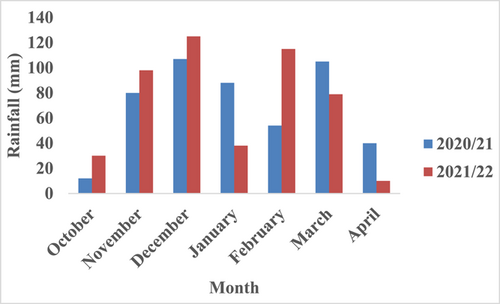
2.3 Soil sampling and analysis
A transverse soil sampling technique was used to obtain 15 soil samples before planting during first season from a depth of 0–40 cm. Collected samples were mixed thoroughly in a plastic bucket and shade-dried to produce a representative sample (I kg) after passing soil through a 2 mm sieve. The following parameters were determined: total N using Kjeldahl method (Cottenie, 1980), pH by calcium chloride method (CaCl2), soil texture using Bouyoucos hydrometer method (Henderson & Bui, 2002). Soil organic carbon and available P were determined using method describe by Olsen (1954). Exchangeable bases (Calcium, magnesium, K and sodium) were determined using Atomic Absorption Spectrophotometer.
2.4 Experimental design
The field experiment used split-plot design with two IRWH techniques as namely PP and TR were compared to farmer practice which used conventional tillage (CT) as main plot factor. PPs were prepared using had hoe to a depth of 0.15 m and width of 0.2 m (Figure 2). TRs were prepared using animal-drawn mouldboard plough and cross ties were done using hand hoe at 1.5 and 3.0 m interval to create microbasin to collect water (Figure 3). Ridges were having a height of 0.4 m at a gradient of 1% across the slope spaced at 0.9 m between rows. Under CT, land was ploughed using animal-drawn mouldboard plough to a depth of 0.2 m. Cattle manure used contain 1.1% N and NPK fertiliser (7%N:14%P2O5:7%K2O) and these two were mixed using rates commonly used by farmers in the study area. Farmers in the study area who apply NPK fertiliser used either 25, 50 or 100 kg ha−1 and those who use cattle manure apply 2.5, 5 or 7.5 t ha−1. These affordable rates were used to come up with INM rates. INM was produced by mixing 25, 50 and 100 kg ha−1 NPK fertiliser with 2.5, 5 and 7.5 t ha−1 cattle manure to come up with 29.25, 58.5 and 89.5 kg N ha−1. INM at three application rates (29.25, 58.5 and 89.5 kg N ha−1) compared to no amendment were used as subplot factor. Each main plot treatment was 12 m long by 8 m wide. All treatment plots received 34.5 kg N ha−1 as ammonium nitrate using split application 28 and 56 days after planting at a rate of 100 kg ha−1 per split. A medium maturity maize variety (SC649) was planted at a spacing of 0.9 m between rows and 0.3 m within rows, with two seeds placed per station and thinned to one 14 days after emergency to produce a plant population of 37,037 plants ha−1.
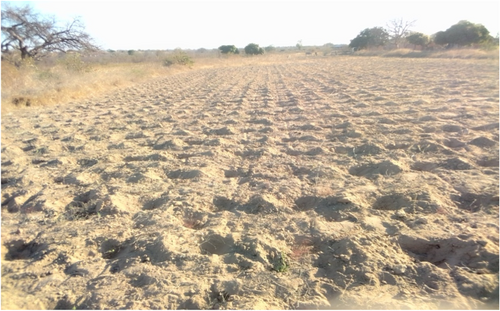
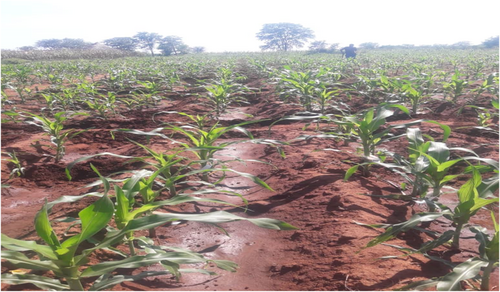
2.5 Data collection
(Kugedera, Nyamadzawo, & Mandumbu, 2022).
(Gram et al., 2020).
Total income from maize was determined by multiplying maize yield per treatment with Grain Marketing Board price per tonne.
2.6 Data analysis
Return on investment was obtained by determining labour cost through labour analysis and calculating other expenses incurred. Labour analysis was done by multiplying number of person and time taken (hours) to complete land preparation ha−1. Total hours were converted to man-days where 1 man-day is equivalent to 8 h. Labour cost was determined by multiplying man-days by cost for 1 man-day. In Zimbabwe, 1 man-day cost US$5. Total revenue was calculated by multiplying maize grain yield ha−1 by prevailing market price each year. Total variable cost (TVC) was determined by summing costs of all activities and inputs (seed, fertiliser, fertiliser application, thinning, harvesting, shelling and storage bag costs) for each main plot factor. Return on investment was determined by subtracting TVC from total revenue per each main plot factor.
3 RESULTS
3.1 Initial soil characterisation
Initial soil characterisation shows that soils were sandy loam which was slightly acid (Table 1). The soil had 725 g kg−1 sand, 208 g kg−1 silt and 67 g kg−1 clay and characterised with low total N, exchangeable magnesium and soil organic carbon.
| Parameter | 0–40 cm depth |
|---|---|
| pH (CaCl2) | 5.6 |
| Total N (%) | 0.02 |
| Soil organic carbon (%) | 0.2 |
| Extractable P (mg kg−1) | 4.45 |
| Exchangeable bases (cmolc kg−1) | |
| Mg | 0.66 |
| Ca | 1.28 |
| K | 0.23 |
| Na | 0.11 |
| Physical parameter | |
| Bulk density (g cm−3) | 1.58 |
| Sand (%) | 72.5 |
| Silt (%) | 20.8 |
| Clay (%) | 6.7 |
| Texture | Sandy loam |
3.2 Effects of IRWH and N application rates on maize grain yield
In situ RWH practices × N interaction influenced maize grain yield significantly (p < 0.05) in the 2020/21 and 2021/22 cropping season (Table 2). In situ RWH practices significantly influenced (p < 0.05) maize grain yield with results showing the following trend TR > PP > CT. Similarly, N application had significant effects (p < 0.05) maize grain yield with 89.5 kg N ha−1 performed better than other application rates, showing the following trend 89.5 > 58.5 > 29.25 > 0 kg N ha−1 over two cropping season (Table 2). However, there was no significant differences between CT, PP and TR at 0 kg N ha−1 during both cropping seasons (Table 2). Maize grain yield significantly increased during 2021/22 cropping season regardless of IRWH practice and N application rates. Maize grain yields were also influenced by season, IRWH, N application rates and IRWH × N application rate interactions. Interactive effects of TR and 89.5 kg N ha−1 influenced maize grain yield considerably compared to other IRWH × N application rates interactions.
| Grain yield (kg ha−1) | Grain yield (kg ha−1) | |||||||||
|---|---|---|---|---|---|---|---|---|---|---|
| 2020/21 | 2021/2022 | |||||||||
| N application rate (kg N ha−1) | N application rate (kg N ha−1) | |||||||||
| IRWH | 0 | 29.25 | 58.5 | 89.5 | Mean | 0 | 29.25 | 58.5 | 89.5 | Mean |
| CT | 895a | 1190b | 2745c | 3968c | 2224.8c | 925a | 1356b | 2795c | 4045c | 2280.3c |
| PP | 975a | 1486a | 3589b | 4936b | 2746.5b | 1045a | 1497ab | 3640b | 4980b | 2790.5b |
| TR | 1016a | 1642a | 4784a | 6373a | 3453.8a | 1185a | 1780a | 4815a | 6538a | 3579.5a |
| N mean | 962a | 1439ab | 3706b | 5092b | 1052a | 1544a | 3750b | 5188b | ||
| LSD (0.05) | 438.8 | 320.6 | ||||||||
| p Value | 0.012 | 0.001 | ||||||||
| CV (%) | 4.7 | 3.2 | ||||||||
- Note: Superscript letters a,b,c indicate p < 0.05.
- Abbreviations: CT, conventional tillage; CV, coefficient of variation; IRWH, in situ rainwater harvesting; LSD, Fisher's Least significant difference; N, nitrogen; PP, planting pit; TR, tied ridge.
3.3 Effects of IRWH and N application rates on RWUE
Results in Table 3 show that RWUE was significantly influenced (p < 0.05) by interaction of RWH practice and N application rates. RWUE was also significantly increased (p < 0.05) with increase in N application rates with the following trend 0 < 29.25 < 58.5 < 89.5 kg N ha−1 during 2020/21 and 2021/22 cropping season. Highest RWUE (13.11; 13.11 kg ha−1 mm−1) was observed from interaction of TR and 89.5 kg N ha−1 and was significantly different (p < 0.05) from all other IRWH and N application interaction during 2020/21 and 2021/22, respectively. Results observed show that TR performed significantly better than other IRWH practices, with CT having the lowest RWUE throughout all N application rates during the two-cropping season (Table 3).
| RWUE (kg ha−1 mm−1) | RWUE (kg ha−1 mm−1) | |||||||||
|---|---|---|---|---|---|---|---|---|---|---|
| 2020/21 | 2021/2022 | |||||||||
| N application rate (kg N ha−1) | N application rate (kg N ha−1) | |||||||||
| IRWH | 0 | 29.25 | 58.5 | 89.5 | Mean | 0 | 29.25 | 58.5 | 89.5 | Mean |
| CT | 1.84a | 2.45a | 5.65c | 8.16c | 4.53c | 1.89a | 2.74a | 5.65c | 8.17c | 4.62b |
| PP | 2.01a | 3.06a | 7.38b | 10.16b | 5.65b | 2.11a | 3.02a | 7.35b | 10.06b | 5.64b |
| TR | 2.09a | 3.38a | 9.84a | 13.11a | 7.12a | 2.39a | 3.6a | 9.73a | 13.21a | 7.23a |
| N mean | 1.98a | 2.96a | 7.62b | 10.48b | 2.13a | 3.12a | 7.58b | 10.48b | ||
| LSD (0.05) | 0.98 | 1.1 | ||||||||
| p Value | 0.012 | 0.001 | ||||||||
| CV (%) | 5.6 | 4.1 | ||||||||
- Note: Superscript letters a,b,c indicate p < 0.05.
- Abbreviations: CT, conventional tillage; IRWH, in situ rainwater harvesting; LSD, Fisher's Least significant difference; N, nitrogen; PP, planting pit; RWEU, rainwater use efficiency; RWH, rainwater harvesting; TR, tied ridge.
3.4 Effects of IRWH and N application rates on N use efficiency
Interaction of IRWH and N application rates influenced NUE significantly (p < 0.05) during 2020/21 and 2021/22 cropping season (Figure 4). Observed results show that combination of CT with 58.5 and 89.5 kg N ha−1 did not show significant differences (p > 0.05) and the increase in NUE was insignificant. Similarly, same trend was observed from interaction of PP with 58.5 and 89.5 kg N ha−1 (Figure 4). Treatments with TR performed significantly better (p < 0.05) compared to other RWH practices and its NUE was influenced by season, N and interaction with N. Increasing N application show significant increase (p < 0.05) in NUE except at 58.5 kg N ha−1 where no significant difference was observed during 2020/21 cropping season (Figure 4). Observed results show that NUE decreased after application of 58.5 kg N ha−1 regardless of season and IRWH practice used except for CT.
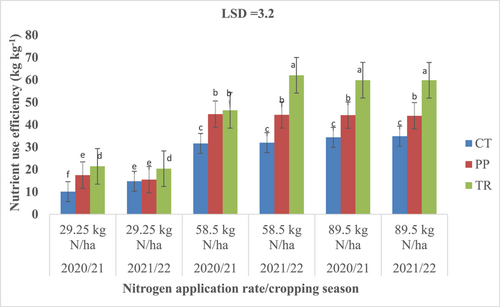
3.5 Effects of IRWH and N on return on investment
Return on investment was influenced significantly (p < 0.05) by interaction of IRWH and N (Figure 5). Interaction of TR and N had positive return on investment during both seasons and significantly increased with application rate following a trend: 0 < 29.25 < 58.5 < 89.5 kg N ha−1. Highest (US$1747.23) return on investment was observed from treatments with TR × 89.5 kg N ha−1 during 2021/22 although showing no significant difference (p < 0.05) with same treatment during 2020/21. All treatments with CT had the lowest return on investment per N rate compared to other IRWH practices (Figure 5). Effects of IRWH were also significant (p < 0.05) showing a trend: TR > PP > CT and similarly the same for N which had highest return on investment from an application rate of 89.5 kg N ha−1. Results show that farmers are subject to loss if they use CT and PP without nutrient sources (Figure 5).
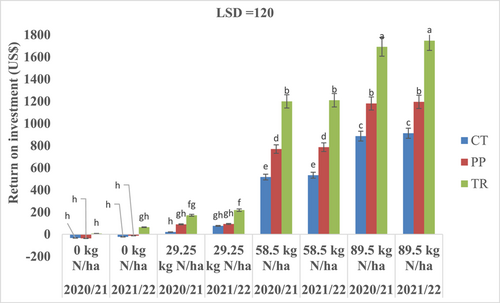
4 DISCUSSION
Maize grain yield is mainly constrained by soil infertility due to inadequate nutrient supply and soil moisture stress in rainfed agriculture especially in semiarid areas of SSA (Chiturike et al., 2023). This call for measures needed to mitigate effects of climate change caused by rainfall variability and soil infertility in semiarid areas of SSA to improve crop production and reduce food insecurity (Bado et al., 2022; Kugedera, Mandumbu, & Nyamadzawo, 2023; Mahinda et al., 2018). Maize grain yields increased with increase in INM application rates and the use of RWH techniques. The use of TRs had better maize grain yields because they have capacity to capture more rainwater, increase infiltration and reduce soil erosion. This concur with studies by Mudatenguha et al. (2014) and Chiturike et al. (2023) who reported increased maize grain yields with the use of TR. Limited use of RWH practices was explained by Nyamadzawo et al. (2013) and Nyagumbo et al. (2019) who reported that adoption of soil and water conservation techniques have been very low in semiarid areas due to high labour requirements and lack of technical knowledge. Poor mechanisation in smallholder farming environments has also contributed to low adoption of soil and water conservation techniques (Hamilton et al., 2022). Related study by Kugedera, Mandumbu, Nyamadzawo, et al. (2023) and Swai et al. (2023) indicated that most farmers in semiarid areas of Africa are not fully aware about the benefits of soil and water conservation and nutrient management practices.
This study show that the use of TR and microdosing of N has the potential to improve maize grain yield, RWUE, NUE and return on investment. CT had low RWUE compared with TR and PP because these two techniques harvest rainwater and store it for longer periods allowing better utilisation by crops especially during dry spell. Furthermore, nutrient use efficiency is improved with availability of water which increase nutrient absorption. Related research by Swai et al. (2023) shows that TR improve maize grain yield and RWUE hence results from this study were in support of those findings in Tanzania. Microdosing of nutrient sources reduce wastage by increasing grain yield and NUE as plant roots compete for these low nutrient quantities available in the soil (Desta et al., 2022; Mwadalu, 2022). Application rate of 58.5 kg N ha−1 performed best on NUE especially with TR, maybe due to high better moisture retained by TR. This was similar to related study by Kugedera, Nyamadzawo, and Mandumbu (2022) who reported better NUE under tied contour at low INM application rates. TRs have better potentials of mitigating climate change (Mahinda et al., 2018) by harvesting high water capacity, increase soil moisture for easy nutrient absorption and this increase NUE.
When farmers use animal-drawn mouldboard plough to prepare TR, the cost of land preparation is reduced and this create TR a low-cost technology. Return on investments was improved with application of high N doses as this increase maize grain yield and total revenue. TR had the highest return on investment due to low labour requirements and better grain yield as witnessed by positive return on investment even when no amendment was added. This coincides with study by Swai et al. (2023) who reported reduction in labour cost from TRs and high gross margin from same treatment. Application rate of 89.5 kg N ha−1 gave the highest return on investment because of higher maize grain yields and total revenue which surpass TVSs by wider margin.
5 CONCLUSION
Management of climate change mitigations and crop production under rainfed agriculture in semiarid areas where smallholder farmers are resource endowed is a critical task. Basing on results from this study, there is need to adopt the use of TR and INM to improve maize grain yields, RWUE, NUE and return on investment. TRs and N microdosing proved to have a potential in increasing maize grain yields, RWUE, NUE and return on investments. it was beneficial for smallholder farmers to use TR and INM of cattle manure and NPK fertiliser. Farmers are recommended to adopt the use of TR and 89.5 kg N ha−1 as a potential strategy to improve maize grain yields, RWUE, NUE and return on investment under rainfed agriculture in smallholder farming areas. However, there is need to look on labour requirements, economic factors and other complications such as rainfall variability and soil texture.
AUTHOR CONTRIBUTIONS
Andrew T. Kugedera developed conceptual framework and designed the experiment. Andrew T. Kugedera and Letticia K. Kokerai collected and analysed data and wrote the paper.
ACKNOWLEDGEMENTS
Farmers in ward 33 of Masvingo District are especially Zvinyaningwe area are well acknowledged for their support during the experimental period.
CONFLICT OF INTEREST STATEMENT
The authors declare no conflict of interest.
ETHICS STATEMENT
The authors confirm that they have adhered to the ethical policies of the journal.
Open Research
DATA AVAILABILITY STATEMENT
The data that supports the findings of this study are available in the manuscript.




